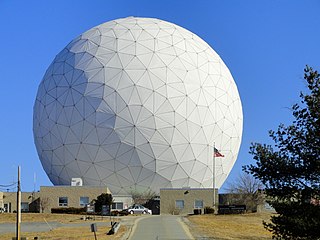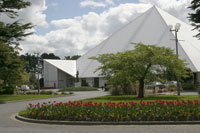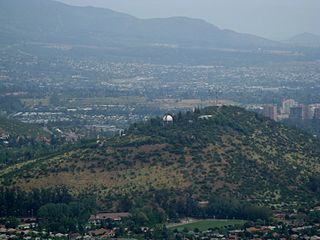
Yerkes Observatory is an astronomical observatory located in Williams Bay, Wisconsin, United States. The observatory was operated by the University of Chicago Department of Astronomy and Astrophysics from its founding in 1897 to 2018. Ownership was transferred to the non-profit Yerkes Future Foundation (YFF) in May 2020, which began restoration and renovation of the historic building and grounds. Re-opening for public tours and programming began May 27, 2022.
Boyden Observatory is an astronomical research observatory and science education centre located in Maselspoort, 20 kilometres (12 mi) north-east of the city of Bloemfontein in Free State, South Africa. The observatory is managed by the Physics Department of the University of the Free State (UFS). The Friends of Boyden assist the observatory as a public support group, organising open evenings and protecting its public interest. Boyden also makes use of members of ASSA Bloemfontein Centre, the amateur astronomy club of the city, for presenters and telescope assistants.

University of Canterbury Mount John Observatory (UCMJO), previously known as Mt John University Observatory (MJUO), is New Zealand's premier astronomical research observatory. It is situated at 1,029 metres (3,376 ft) ASL atop Mount John at the northern end of the Mackenzie Basin in the South Island, and was established in 1965. There are many telescopes on site including: one 0.4-meter, two 0.6-meter, one 1.0-meter, and a new 1.8-meter MOA Telescope. The nearest population center is the resort town Lake Tekapo (pop. >500). Approximately 20% of nights at MJUO are photometric, with a larger number available for spectroscopic work and direct imaging photometry.

Stardome Observatory is a public astronomical observatory situated in Maungakiekie/One Tree Hill Domain in Auckland, New Zealand.

South African Astronomical Observatory (SAAO) is the national centre for optical and infrared astronomy in South Africa. It was established in 1972. The observatory is run by the National Research Foundation of South Africa. The facility's function is to conduct research in astronomy and astrophysics. The primary telescopes are located in Sutherland, which is 370 kilometres (230 mi) from Observatory, Cape Town, where the headquarters is located.
The Astronomical Observatory of Belogradchik or Belogradchik Observatory is an astronomical observatory owned and operated by the Institute of Astronomy of the Bulgarian Academy of Sciences. It is located near the town of Belogradchik in northwestern Bulgaria, at the foot of the Western Balkan Mountains. The other observatory operated by the same institute is the Rozhen Observatory.
Leuschner Observatory, originally called the Students' Observatory, is an observatory jointly operated by the University of California, Berkeley and San Francisco State University. The observatory was built in 1886 on the Berkeley campus. For many years, it was directed by Armin Otto Leuschner, for whom the observatory was renamed in 1951. In 1965, it was relocated to its present home in Lafayette, California, approximately 10 miles (16 km) east of the Berkeley campus. In 2012, the physics and astronomy department of San Francisco State University became a partner.

The Vainu Bappu Observatory is an astronomical observatory owned and operated by the Indian Institute of Astrophysics. It is located at Kavalur in the Javadi Hills, near Vaniyambadi in Tirupathur district in the Indian state of Tamil Nadu. It is 200 km south-west of Chennai and 175 km south-east of Bangalore.

The Royal Observatory, Edinburgh (ROE) is an astronomical institution located on Blackford Hill in Edinburgh. The site is owned by the Science and Technology Facilities Council (STFC). The ROE comprises the UK Astronomy Technology Centre (UK ATC) of STFC, the Institute for Astronomy of the School of Physics and Astronomy of the University of Edinburgh, and the ROE Visitor Centre.

Marseille Observatory is an astronomical observatory located in Marseille, France, with a history that goes back to the early 18th century. In its 1877 incarnation, it was the discovery site of a group of galaxies known as Stephan's Quintet, discovered by its director Édouard Stephan. Marseille Observatory is now run as a joint research unit by Aix-Marseille University and the French National Center for Scientific Research (CNRS).

Haystack Observatory is a multidisciplinary radio science center, ionospheric observatory, and astronomical microwave observatory owned by Massachusetts Institute of Technology (MIT). It is located in Westford, Massachusetts (US), approximately 45 kilometers (28 mi) northwest of Boston. Haystack was initially built by MIT's Lincoln Laboratory for the United States Air Force and was known as Haystack Microwave Research Facility. Construction began in 1960, and the antenna began operating in 1964. In 1970 the facility was transferred to MIT, which then formed the Northeast Radio Observatory Corporation (NEROC) with a number of other universities to operate the site as the Haystack Observatory. As of January 2012, a total of nine institutions participated in NEROC.

The Robinson Observatory is an astronomical observatory owned and operated by the University of Central Florida College of Sciences in Orlando, Florida, USA.

Mills Observatory is the first purpose-built public astronomical observatory in the UK, located in Dundee, Scotland. Built in 1935, the observatory is classically styled in sandstone and has a distinctive 7 m dome, which houses a Victorian refracting telescope, a small planetarium, and display areas. The dome is one of two made from papier-mâché to survive in the UK, the other being at the Godlee Observatory.
The Dunedin Astronomical Society Incorporated (DAS) is an amateur astronomical group operating from the Beverly-Begg Observatory Dunedin, New Zealand. It is affiliated with the Royal Astronomical Society of New Zealand and with the Otago Institute.

The Southland Astronomical Society is the southernmost astronomical society in the world. Based in Invercargill at the southern tip of New Zealand's South Island, its small, active group of about 36 amateur astronomer members participate in a variety of astronomical activities including education with groups and school children, deep sky observing, astrophotography and aurora observation.

The Meade LX200 is a family of commercial telescopes produced by Meade Instruments launched in 1992 with 8" (20.32 cm) and a 10" (25.4 cm) Schmidt–Cassegrain models on computerized altazimuth mounts. Two larger models, a 12" (30.48 cm) and a 16" (40.64 cm), quickly followed. The original version was later informally named the "classic" LX200 as newer upgraded versions replaced it. The first of these was the LX200GPS, which featured global positioning system electronics. A 360 mm (14 in) LX200GPS was later added to the line.

The National Astronomical Observatory of Chile is an astronomical observatory owned and operated by the Department of Astronomy of the University of Chile (UCh). It is located on Cerro Calán, a hill in the commune of Las Condes. The commune is an eastern suburb of Santiago located in Santiago Province of the Santiago Metropolitan Region. OAN was founded in 1852 and became a part of UCh in 1927. The facility on Cerro Calán was completed in 1962.

Arthur Beverly was a New Zealand watchmaker, mathematician and astronomer.

The Astronomical Society of Victoria (ASV) is an amateur astronomy club in the state of Victoria, Australia. It was founded in 1922, making it one of the oldest such clubs in the country, and with some 1500 members it claims to be one of the largest amateur astronomy organisations in the southern hemisphere. Membership is open to all with an interest in astronomy, and the society caters for people with a wide range of ages, backgrounds, abilities and interests.

The Carkeek Observatory is the earliest surviving astronomical observatory in New Zealand. It was built around 1867 by retired customs officer and amateur astronomer Stephen Carkeek on his farm south of Featherston in the Wairarapa. The timber building was in two parts: an octagonal room with a rotating canvas dome, and a rectangular annex. Carkeek died in 1878 and the disused observatory became a farm equipment shed. As late as the 1980s it was still largely intact, but is now a partial ruin, although the annex and parts of the rotation mechanism can still be seen in place. It was added as a Category I historic place in the New Zealand Heritage List on 26 June 2020.

















